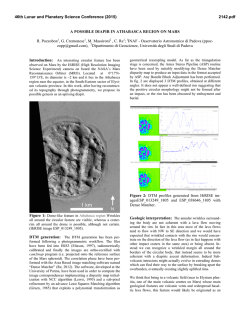
geodynamics of subduction zones: from numerical models to
GEOS GEOS, Vol. 25, No. 1, Noviembre, 2005 SESION ESPECIAL GEODYNAMICS OF SUBDUCTION ZONES: FROM NUMERICAL MODELS TO SEISMOLOGY AND POTENCIAL FIELD METHODS A SESSION IN HONOR OF HARTMUT JODICKE MARTES SALON 1 MISMALOYA GEODYNAMICS OF SUBDUCTION ZONES: FROM NUMERICAL MODELS TO SEISMOLOGY AND POTENCIAL FIELD METHODS A SESSION IN HONOR OF HARTMUT JODICKE 238 GEOS GEOS, Vol. 25, No. 1, Noviembre, 2005 GEOS GEOS, Vol. 25, No. 1, Noviembre, 2005 SE03-1 GEODYNAMICS OF SUBDUCTION ZONES: FROM NUMERICAL MODELS TO SEISMOLOGY AND POTENCIAL FIELD METHODS A SESSION IN HONOR OF HARTMUT JODICKE SE03-2 GEOPHYSICAL MODELING OF VALLE DE BANDERAS GRABEN Arzate Flores Jorge (Centro de Geociencias, Campus UNAM-Juriquilla), Alvarez Béjar Román (Instituto de Investigaciones en Matemáticas Aplicadas y en Sistemas, UNAM, CU, México DF, 04510), Yutsis Vsevolod (Facultad de Ciencias de la Tierra, UANL, Linares N.L.), Pacheco Martínez Jesús (Centro de Geociencias, Campus UNAMJuriquilla) y López Loera Héctor (IPICYT, San Luis Potosí, S.L.P.) [email protected] A gravimetric survey consisting of five lines and 483 stations, as well as a magnetotelluric (MT) survey consisting of 17 obser vation sites, were made in the Valle de Banderas region for the determination of the structural characteristics of the valley. Additionally, an aeromagnetic survey previously made was analyzed to correlate with the above geophysical measurements. Gravimetric and MT models were derived from those determinations, which confirm that the valley corresponds to a general graben structure with slumped blocks that vary from deep emplacements (2000 m) close to Banderas Bay to shallow ones (100 m) toward the NE end of the valley. Faults flanking the valley, infer red from the gravity and magnetic models, can be connected with offshore faults in Bahía de Banderas, indicating a structural connection between Banderas Bay and Banderas Valley. From the MT measurements we conclude that a 2-D resistivity behavior is observed within the graben structure whereas outside of the graben limits the behavior is 1-D, in spite of the mountainous character of the region. Gravimetric models suggest the occurrence of basin-like structures within the valley’s graben, coinciding with similar structures reported elsewhere within Banderas Bay, indicating that this may be a typical erosional feature of the graben structure. The aeromagnetic data correlates with the gravimetric and MT models, and suggests that the graben structure is an extensional zone separating granite blocks with similar magnetic signatures; it also indicates that the extensional zone continues NE beyond the limit of Banderas Valley. These results tend to confirm that Banderas Bay and Banderas Valley belong to the same tectonic structure in spite of an approximate change in orientation of 30° between them, and strengthen the idea that these structures constitute part of the NW limit of the Jalisco Block. CONDUCTIVIDAD ELÉCTRICA Y MICROSISMICIDAD EN LA REGIÓN DE OJOS NEGROS, ENSENADA B. C., MÉXICO. Antonio Carpio Ricardo, Romo Jones José Manuel, Frez Cárdenas José y Suárez Vidal Francisco Centro de Investigación Científica y Educación Superior de Ensenada [email protected] La región de Ojos Negros, ~50 km al Este de la ciudad de Ensenada, es una zona con gran actividad sísmica, ubicada en la Sier ra Peninsular, en el norte de Baja California. La mayor actividad es de sismos con ML<4.0, aunque en su cercanía se han registrado eventos de magnitud > 6.0 (1954, 1956), asociados al rompimiento del sector sur de la falla de San Miguel (FSM), una de las estructuras más activas de la zona. Los epicentros de la región de Ojos Negros se distribuyen cubriendo un área de unos 50 km2 entre la FSM (al NE) y las fallas Ojos Negros y Tres Hermanas (al SO), y sólo alguna poca actividad puede asociarse con el trazo de las fallas; los mecanismos focales indican un régimen extensional con el acimut promedio del eje P en dirección N-S. En este trabajo utilizamos datos magne-to-telúricos medidos en 17 sitios a lo largo de un perfil que cruza la región, para investigar la distribución de la conductividad eléctrica, tanto en la zona sismogénica como fuera de ella. Los datos, observados en una banda de frecuencia entre 0.001 y 100 Hz, se interpretaron utilizando un algoritmo de inversión en 2-D, para obtener como resultado una imagen de la resistividad eléctrica del subsuelo en la sección transversal. Los resultados muestran una anomalía conductora (~10 Ohm-m) a unos 15 ± 3 km de profundidad, bajo el valle de Ojos Negros. La mayor parte de los hipocentros se localizan bordeando a este conductor, en la zona en donde el gradiente de la resistividad es mayor. L a zona sismogénica de la FSM se muestra como una región medianamente conductora (~300 Ohm-m), mientras que las rocas graníticas del batolito peninsular (corteza superior) tienen altas resistividades (>3000 Ohm-m) y la corteza inferior, asísmica, presenta la resistividad más baja (< 30 Ohmm). La anomalía conductora puede asociarse a una corteza con mayor contenido de fluidos, lo que está de acuerdo con la idea de una zona de transición o sutura entre dos terrenos de origen y composiciones distintas. La distribución observada de microsismos puede estar asociada a fracturas provocadas por el ascenso de fluidos desde la corteza profunda. 239 GEODYNAMICS OF SUBDUCTION ZONES: FROM NUMERICAL MODELS TO SEISMOLOGY AND POTENCIAL FIELD METHODS A SESSION IN HONOR OF HARTMUT JODICKE SE03-3 P R O PPA AGA TION OF THE 2001-2002 SILENT ATION EARTHQUAKE IN THE MEXICAN SUBDUCTION ZONE Kostoglodov Vladimir (Instituto de Geofísica, UNAM), Franco Sánchez Sara Ivonne (Instituto de Geofísica, UNAM, Mexico City, Mexico), L arson Kristine M. (Department of Aerospace Engineering Science, University of Colorado, Boulder, CO, USA), Manea Vlad C. (Caltech, Pasadena, CA, USA), Manea Marina (Caltech, Pasadena, CA, USA) y Santiago Santiago Jose Antonio (Instituto de Geofísica, UNAM, Mexico City, Mexico) v l a d i @ s e r v i d o r. u n a m . m x Among a number of silent earthquakes (SQ) recently recorded by GPS in different subduction zones (Japan, Alaska, Cascadia, New Zealand) the aseismic slow slip event of 2001-2002 in Guerrero, Mexico is the largest one with the equivalent magnitude Mw ~7.5. Sub-horizontal and shallow plate interface in the Central Mexico produces specific conditions for the ~100 km extended zone of slow transient where the SQs develop from ~80 to ~190 km inland from the trench. This wide transient zone and large slow slips of 10-20 cm on the subduction fault result in the noticeable surface displacements up to 5 cm during the SQs. Continuous GPS stations provide reliable data to trace the propagation of SQs, and to estimate the arrival time, duration and geometric attenuation. The knowledge of these propagation parameters is important to understand the origin of slow slip events and their triggering effect on large subduction earthquakes. We use the long-base tiltmeter data to define new time limits for the SQs and continuous records at 8 GPS stations to determine the propagation of the 2001-2002 SQ in Mexico. It occurs that the surface deformation from this SQ commenced almost instantly at the C AYA and IGUA GPS stations separated by ~170 km and located along the profile perpendicular to the trench. The SQ then propagated laterally parallel to the coast at ~2 km/day with an exponential attenuation of horizontal surface displacement and a linear decrease of the duration with the distance. Campaign data measured every year from 2001 to 2005 at the Oaxaca GPS network are modeled by a propagation of the 2001-2002 SQ displacement pulse. This modeling shows that the SQ ceased gradually in the central part of the Oaxaca subduction zone segment (Puerto Angel) and then apparently triggered another SQ in the SE Oaxaca (between Puerto Angel and Salina Cruz). 240 GEOS GEOS, Vol. 25, No. 1, Noviembre, 2005 SE03-4 LOW TEMPERA TURE AND HIGH AMPLITUDE TEMPERATURE MAGNETIC ANOMAL Y BENEA TH CHIAP AS: ANOMALY BENEATH CHIAPAS: EVIDENCE FOR A HIGHL Y SERPENTINIZED HIGHLY MANTLE WEDGE Manea C ALTECH, Marina y Manea Vlad Constantin Seismological L aborator y, Pasadena, [email protected] USA Southern Mexico is an interesting area where the subducting Cocos slab drastically changes its geometry: from a flat slab in Central Mexico to a ~ 45º dip angle beneath Chiapas. Also, the cur rently active volcanic arc, the modern Chiapanecan volcanic arc, is oblique and situated far inland from the Middle America trench, where the slab depth is ~ 200 km. In contrast, the Central America volcanic arc is parallel to the Middle America trench and the slab depth is ~ 100 km. A 2D steady state thermo-mechanical model explains the calc-alkaline volcanism by high temperature (~ 1300º C) in the mantle wedge just beneath the Central America volcanic arc and strong dehydration (~ 5 wt.%) of the Cocos slab. In contrast, the thermal model for the modern Chiapanecan volcanic arc shows high P-T conditions beneath the coast where the Miocene Chiapanecan extinct arc is present, and is therefore unable to offer a reasonable explanation for the origin of the modern Chiapanecan volcanic arc. We propose a model in which the origin of the modern Chiapanecan volcanic arc is related to the space-time evolution of the Cocos slab in Central Mexico. The initiation of flat subduction in Central Mexico in the middle Miocene would have generated a hot mantle wedge inflow from NW to SE, generating the new modern Chiapanecan volcanic arc. Because of the contact between the hot mantle wedge beneath Chiapas and the proximity of a newly formed cold flat slab, the previous hot mantle wedge in Chiapas became colder in time, finally leading to the extinction of the Miocene Chiapanecan volcanic arc. The position and the distinct K-alkaline volcanism at El Chichón volcano are proposed to be related to the arrival of the highly serpentinized Tehuantepec Ridge beneath modern Chiapanecan volcanic arc. The deserpentinization of Tehuantepec Ridge would have released significant amounts of water into the overlying mantle, therefore favoring vigorous melting of the mantle wedge and probably of the slab. GEOS GEOS, Vol. 25, No. 1, Noviembre, 2005 GEODYNAMICS OF SUBDUCTION ZONES: FROM NUMERICAL MODELS TO SEISMOLOGY AND POTENCIAL FIELD METHODS A SESSION IN HONOR OF HARTMUT JODICKE SE03-5 PACIFIC PL ATE REJUVENA TIO N FR O M PL REJUVENATIO PLUME UME ACT IN FRONT OF THE KAMCHA TK A TRENCH: IMPACT KAMCHATK IMP A MECHANISM TO PRODUCE ADAKITIC MAGMAS FOR OLD AND FFAST AST SUBDUCTION ZONES Manea C ALTECH, Vlad Constantin y Manea Marina Seismological L aborator y, Pasadena, [email protected] USA The Kamchatka subduction zone is one of the most active seismic and volcanic regions in the world and located in the proximity of the Meiji Guyot mantle plume. We propose a convection model which shows the a hot plume rising from depths grater that 1000 km would bend toward the trench, being deflected near surface by the Pacific plate movement. Geochemical studies of volcanic rocks in Central Kamchatka show a complex pattern, from basalts of intermediate composition to alkaline basalts of plume type and adakites. Our models suggest that the buoyant plume cannot penetrate the cold subducting slab in order to enrich the mantle wedge and to produce the alkaline plume type basalts. Instead, a gap in the subduction process, likely created by accretion of new terrains, would create an easy way for the hot plume material to enrich the mantle wedge. The contact between the hot plume and the oceanic plate offshore Kamchatka produces a rejuvenation of the ~100 Ma old Pacific plate and lowering the thermal age to less than 26 Ma. 2D steady state thermal models with such hot incoming slab show that the oceanic crust beneath the active volcanic arc has undergone melting and therefore adakitic volcanism. SE03-6 FLUIDS RELEASE C O C O S P L ATE AND CRUST DEDUCED STUDIES IN FROM THE SUBDUCTED PPA AR T I A L M E LLTING TING OF THE RT FROM MAGNETOTELLURIC SOUTHERN MEXICO Jodicke Hartmut (Institut für Geophysik der Westfälischen W ilhelms-Universität Münster, Germany), Jording Alexander (Institut für Geophysik der Westfälischen W ilhelms-Universität Münster, Germany), Ferrari Luca (Centro de Geociencias, Campus UNAM-Juriquilla, Querétaro, Qro., México), Arzate Flores Jorge (Centro de Geociencias, Campus UNAM-Juriquilla, Querétaro, Qro., México), Mezger Klaus () y Rupke Lars (Institut für Marine Geowissenschaften (GEOMAR), Kiel, Germany) were carried out in southern Mexico along two coast to coast profiles. The first line, running from Puerto Escondido to Tlacotalpan, is void of recent volcanism, whereas the second line further to the north, running from Acapulco to Tampico, crosses the Transmexican Volcanic Belt (TMVB) near the active volcano Popocatépetl. The conductivity-depth distribution was obtained by simultaneous 2D inversion of the TM and TE modes of the magnetotelluric transfer functions after Groom and Bailey´s decomposition and static shift corrections for part of the sites were done. The MT models demonstrate that the subducting plate itself is not seen electrically. Instead, the southern profile shows several zones of enhanced conductivity in the deep crust clearly separated from each other. In contrast, the northern profile is clearly dominated by an elongated conductive zone extending more than 250 km below the TMVB and beyond. The isolated conductivity anomalies on the southern profile are interpreted as originating from chemically bounded aqueous fluids, released from the basaltic oceanic crust at increasing p,T conditions during subduction, and trapped in the overlying deep continental crust. By comparison with the pressure-temperature diagram of metamorphic facies for a fully hydrated basaltic bulk composition, and adopting a moderate dip of the slab of about 13° from refraction seismic results, the conductivity anomalies may be related to the main dehydration reactions at the zeolite  blueschist  eclogite facies transitions and the breakdown of chlorite at increasing depths. This relation allows to estimate a geothermal gradient of ~8.5 °C/km for the top of the subducting plate. Trench-near conductivity anomalies are the result of water expelled by pressureinduced closure of water-filled open pores and fractures, and the decomposition of clay minerals. The same dehydration reactions may be recognized along the northern profile at the same position relative to the depth of the plate, but more inland due to a smaller dip, and merged together near the volcanic front due to a steep down-bending of the plate. When the oceanic crust has reached a depth of 80 – 90 km, ascending fluids produce basaltic melts in the intervening hot continental mantle wedge that give rise to the volcanic belt. In part, water-rich basalts may intrude into the lower continental crust generating partial melting of granulites. The elongated high conductive zone below the TMVB may therefore depict a complex of partial melts and fluids of various origin, ongoing migmatization, ascending basaltic and granitic melts, growing plutons as well as residual metamorphic fluids. [email protected] In order to study electrical conductivity phenomena that are associated with subduction related fluid release and melt production, magnetotelluric (MT) measurements 241 GEODYNAMICS OF SUBDUCTION ZONES: FROM NUMERICAL MODELS TO SEISMOLOGY AND POTENCIAL FIELD METHODS A SESSION IN HONOR OF HARTMUT JODICKE SE03-7 APLICACIONES DE PDE2D, UN PROGRAMA DE PROPOSITOS GENERALES QUE RESUEL VE RESUELV ECUACIONES DIFERENCIALES PARCIALES Sewell Granville University of Texas at Austin, USA [email protected] PDE2D es un programa de elementos finitos, que resuelve sistemas no-lineales de ecuaciones diferenciales parciales, dependiente o independiente del tiempo, y sistemas lineales de autovalores, en 1D, 2D (regiones arbitrarias), y 3D (regiones no-rectangulares sencillas). Tiene un interfacio interactivo, por lo tanto es muy facil de usar, y usa elementos de hasta cuarto grado, por lo tanto tiene alta precision. www.pde2d.com contiene una lista de mas de 160 publicaciones, muchos de ellos de geofisicia, donde PDE2D se uso para producir los resultados numericos. En este charla, se presentaran algunos aplicaciones tipicas de PDE2D. 242 GEOS GEOS, Vol. 25, No. 1, Noviembre, 2005
© Copyright 2025



